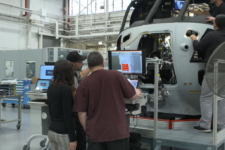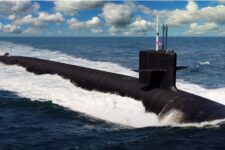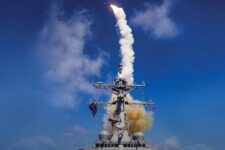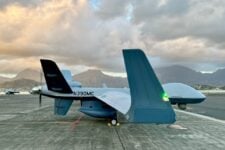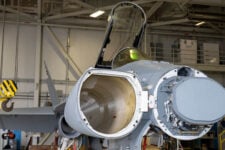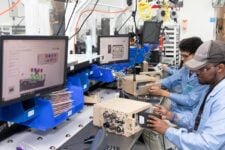
Photo: Courtesy of L3Harris.
The Department of Defense (DoD) began the year with the release of the inaugural National Defense Industrial Strategy (NDIS), a comprehensive overview of the DoD’s strategic vision “to coordinate and prioritize actions to build a modernized defense industrial ecosystem.” While the document’s release is an important step forward in ensuring that the Joint Force retains technological overmatch, the NDIS also lays bare the reality that for the first time since World War II, the U.S. must reassert control over its own defense supply chain destiny.
Wars in Ukraine and the Middle East, alongside rising tensions in the Indo-Pacific, have forced a spotlight on the hard truth that the U.S. Defense Industrial Base (DIB) is at a crossroads on how to execute on DoD’s modernization priorities and maintain the arsenal of democracy.
There is little doubt that American ingenuity and engineering prowess are capable of creating the world’s most sophisticated weapons systems – but sophistication means little if we cannot innovate at the speed of the asymmetric threats. Given the increasingly hostile global security landscape we find ourselves in and adversaries who show no signs of slowing their technological advances, the need for the NDIS and an innovative, robust and resilient defense industrial ecosystem is crystal clear.
But how do we get there?
Successful implementation of the NDIS’ four strategic priorities will require sustained collaboration and partnership between DoD, industry and our international allies and partners. While the road to implementation is sprinkled with roadblocks that DoD and Congress must overcome, they can take action immediately on two fronts.
The first is by spurring a generational shift in the technology innovation model that enables defense capabilities to be developed and deployed at the speed of commercial technology, if not more rapidly. The second, creating resilient supply chains to bolster national security and ensure mission readiness.
A revamped defense technology innovation model with “generational” investment in innovation has long felt like a pipe dream to much of the DIB, which is why its inclusion in the NDIS marks a significant milestone. Amidst constrained budgets, DoD must reevaluate how technology development is funded to maintain a healthy and competitive environment that best harnesses the innovative culture we enjoy as a capitalist society.
Innovation can falter in the current environment as companies are challenged to invest and avoid a net loss while efficiently managing wide swings in raw material availability and inflation, which significantly increase costs. As a result, many companies are now declining to bid on programs where the contract opportunity doesn’t match the risk assumed. This leads to weak competition, modest – not groundbreaking – innovation, inferior products, delayed production and delivery, and an increased risk of losing superiority. Put simply, the pace of modern technological innovation has accelerated far beyond the imagination of Cold War-era engineers; however, the processes that make it possible for the DoD to widely adopt new technologies look troublingly identical to how they did half a century ago. While DoD led the charge in the development of game-changing, now ubiquitous technologies – such as GPS and the internet – most of the latest innovation advancements are coming from the commercial technology sector, including AI and unmanned systems capabilities.
I am hopeful DoD will lean heavily on its industry partners to better understand the changes in the technology development process that need to be prioritized to achieve success. As the Trusted Disruptor for the global aerospace and defense industry, L3Harris is committed to driving the conversation around defense innovation best practices. I shared my perspectives with the Commission on PPBE Reform last year and commend its efforts to drive innovation and capabilities forward, faster. While some of these recommendations will have to be taken up by Congress, others do not and can be adopted immediately to further reinvent and reinvigorate the DIB.
Industry also requires a dependable and adaptable supply chain to produce necessary technologies at speed, scale and cost. In recent years, the DoD has led the way in providing resources necessary to strengthen essential domestic industrial base capabilities by leveraging the Defense Production Act Title III authorities. Doing so has ensured we equip our warfighters with the most effective, efficient and mission-ready capabilities. While Congress faces several challenging budget decisions, our policymakers must continue to prioritize funding for these much-needed investments and ensure accessibility for teammates across the DIB.
Shoring up the supply chain also requires continued investment in next-generation manufacturing methods like digital engineering, additive manufacturing and rapid prototyping, among others. According to the DoD’s 2023 China Military Power Report, China, which Secretary of Defense Lloyd Austin has consistently referred to as our pacing challenge, has seen its People’s Liberation Army expressly focus in this area. It is pursuing next-generation capabilities that incorporate AI and other advanced technologies at every level of warfare. This drives home the importance of refining the roadmap and convergence of these manufacturing methods across the DIB.
An analysis of the defense industrial ecosystem may sound like national security’s sleepy backwater, but in an era of technological transformation, failure to keep pace with the advancements of our adversaries poses an existential threat to the nation. If we are to take advantage of the richness of American innovation to create the next generation of military capabilities, DoD and the DIB must work hand-in-glove to implement the NDIS.
Successful implementation of the strategy may very well be the deciding factor in our future as a global military power. The world we find ourselves in suggests it is all but certain that the U.S. is set for a rendezvous with reality.
Will we be ready?
Christopher E. “Chris” Kubasik is Chair and Chief Executive Officer of L3Harris Technologies, the Trusted Disruptor in the defense industry, and Vice Chair of the Aerospace Industries Association. He co-led the largest defense merger at the time between L3 and Harris to create more competition in the DIB.


